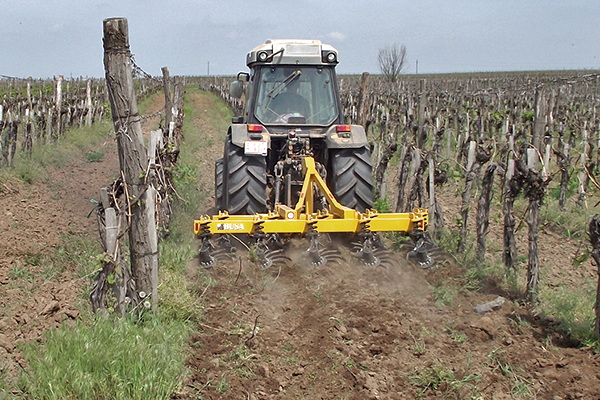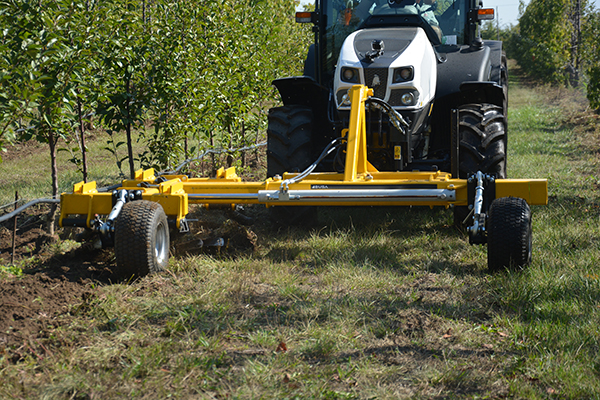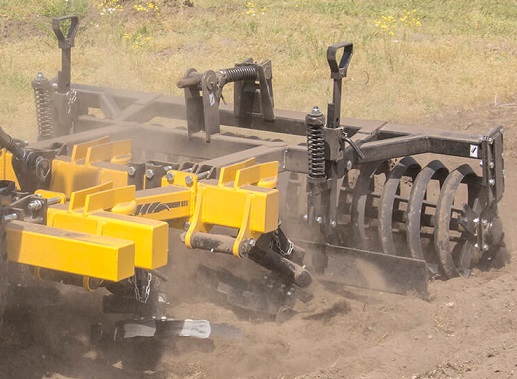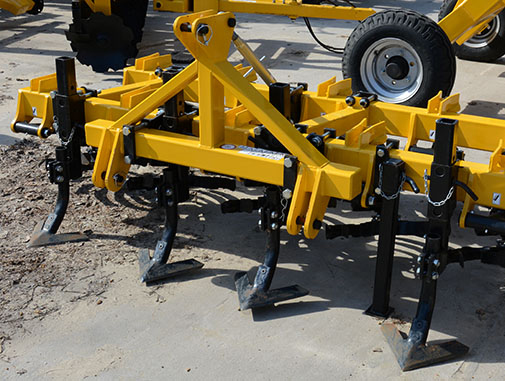WEED REMOVAL
EFFECTIVELY
BUSA™
Rotary
Weeders
WEED REMOVAL
EFFECTIVELY
BUSA™
Rotary
Weeders
Advantages of the BUSA™ Rotary weeders
Energy efficiency
The company’s patented rotary hoe becomes the single most efficient tool of mechanical weed control because of its high working speed (~15 km/h) as well as its clogging-free operation.
Compared to disc harrows, the BUSA™ GYMF performs incredibly efficient weed control faster, while also requiring less energy for the same task.
Organic, pesticide-free weed control
Cover crop control
Smooth surface without earth embarkments
which makes it possible for the machine to move fast and without jolting even with a sprayer or trailer. This allows for a much faster completion of every possible task.
Minimal protective distance, maximum safety
the machine does not get stuck although the trees might suffer small injuries. This is not a problem when it happens occasionally, but generally it is to be avoided. We suggest the application of the K.U.L.T. finger weeder for weed control between plants, which protects tree trunks.
Durability
History of the product family
What exactly is a GYMF?
GYMF is the product name for the rotary weeder using the patented BUSA™ Rotor. It is a special version of our seedbed maker also using the BUSA™ Rotor. Designing this simplified version was necessary because on plantations, fast and efficient cultivation could be achieved with only two lines of Rotors.
It is important to note, however, that collisions may result in small cuts on the trunks. For this reason, it is absolutely forbidden to collide with the plants intentionally and regularly, since this practice can ultimately destroy the whole plantation. In the last few years, various versions of the machine have been designed: three strip cultivator, front and back mounted versions, from small two-rotor machines to huge seven-metre-wide giants.
Why is it worth using the BUSA™ machines?
The rotary weeders using the patented BUSA™ Rotor have a huge economical advantage: time Time is of the essence, and this machine can perform the same task much, much faster than traditional machines, and with the same efficiency! A task which often takes a traditional machine days to complete, can be finished with a GYMF in as little time as a single afternoon. Another advantage is that it can work very close to the cash crops, even 6 cm-s from them, which reduces the size of the uncultivated strip. Furthermore, with the K.U.L.T. finger weeder mounted on the frame…
the spaces between plants can be kept clean as well.
Last but not least, if your plantation is cultivated using the BUSA™ Rotor, the machine’s surface smoothing capabilities will create a surface on which neither the sprayer bounces about, nor will the boxes jump off the trailer.
Surface
In a field where the row spacing is accurate to within +/- 5 cm, it is possible to achieve equally precise approach on both sides. Our product range features several different versions of the hitched rotary weeder, from a small fix-framed version with a 1.1 metre working width to a hydraulically folding giant with a 6 metre working width, and anything in between.
Orchard strip
The double-sided versions are capable of extending 2 metres measured from the centre line of the tractor. A pivoted frame ensures proper surface following. Mounting on the front can increase precision further.
What exactly is the BUSA™ Rotor?
The BUSA™ Rotor is a seedbed maker and primary tillage finisher based on a completely novel concept. It was developed and patented by our founder Benedek Horváth in the beginning of the 80’s.
The BUSA™ Rotor is used on the fields, in between rows and on plantations. It has strong clot breaking and weeding capabilities, thanks to its high speed and acceleration.
A huge advantage of our Rotor compared to rigid tools is that is does not get clogged and does not throw the soil about, which make fast work without constant supervision possible.
Everything you need to know about the components
Frame structure categories
- Surface
- Orchard strip
- Field
GYMF Classic
Basic version, the D 520 rotos are mounted on the beams in fix positions. The beams can be adjusted slightly relative to each other, and the hitch can be slightly repositioned. They are available with a working width from 1.1 meters to 4.3 meters. It can be equipped with various accessories, such as a finisher roller or finger weeder.
GYMF-H
D 620-series rotor configuration, typically with adjustable rotor mounting Simple, robust structure. It is available in configurations ranging from a mini version with 1-1 pairs of rotors to a version with a working width of 6.6 meters. It can also be supplemented with a telescopic third row, which partially regulates the working width.
GYMF RP
Parallel adjustable offset-mounted frames There are variants equipped with 2 to 5 pairs of rotors. An ideal choice when working offset under the canopy. For transportation, the machine retracts to the center of the tractor.
GYMF-H FX (Madonna)
one row runs under the belly of the power machine, with a rotor working on each side, to the right and left. The Rotors rotating away from the trees allow the row to be approached with minimal clearance. The Rotors do not build up a ridge, nor do they dig furrows like discs. The work can be done at high speed, 10-14 km/h is not a challenge.
GYMF RF
The simplest and most effective tool for cultivating orchard strips. The BUSA Rotors are mounted on a fixed frame. For a large width, a manually foldable version is available.
GYMF FT / FT 2x
A tool with a hydraulic telescopic frame and adjustable working width. Typically, one or two BUSA™ Rotor pairs are used. The machine built with D 520 rotors has a height of half a meter, making it suitable for use under low crops. It can be used both in a pushing and pulling configuration. It can also be equipped with one or two gauge wheels.
GYMF NS (2 modules)
The product family is designed to consist of an upper and a lower frame section. The lower frames can be varied with a high degree of freedom, and the D 520 BUSA™ Rotors can be requested with fixed or adjustable mounting.
GYMF-H NS (2 modules)
GYMF Classic
Basic version, the D 520 rotos are mounted on the beams in fix positions. The beams can be adjusted slightly relative to each other, and the hitch can be slightly repositioned. They are available with a working width from 1.1 meters to 4.3 meters. It can be equipped with various accessories, such as a finisher roller or finger weeder.
GYMF-H
D 620-series rotor configuration, typically with adjustable rotor mounting Simple, robust structure. It is available in configurations ranging from a mini version with 1-1 pairs of rotors to a version with a working width of 6.6 meters. It can also be supplemented with a telescopic third row, which partially regulates the working width.
GYMF RP
Parallel adjustable offset-mounted frames There are variants equipped with 2 to 5 pairs of rotors. An ideal choice when working offset under the canopy. For transportation, the machine retracts to the center of the tractor.
GYMF-H FX (Madonna)
one row runs under the belly of the power machine, with a rotor working on each side, to the right and left. The Rotors rotating away from the trees allow the row to be approached with minimal clearance. The Rotors do not build up a ridge, nor do they dig furrows like discs. The work can be done at high speed, 10-14 km/h is not a challenge.
GYMF RF
The simplest and most effective tool for cultivating orchard strips. The BUSA Rotors are mounted on a fixed frame. For a large width, a manually foldable version is available.
GYMF FT / FT 2x
A tool with a hydraulic telescopic frame and adjustable working width. Typically, one or two BUSA™ Rotor pairs are used. The machine built with D 520 rotors has a height of half a meter, making it suitable for use under low crops. It can be used both in a pushing and pulling configuration. It can also be equipped with one or two gauge wheels.
GYMF NS (2 modules)
The product family is designed to consist of an upper and a lower frame section. The lower frames can be varied with a high degree of freedom, and the D 520 BUSA™ Rotors can be requested with fixed or adjustable mounting.
GYMF-H NS (2 modules)
Technical data
-
GYMF Classic
-
GYMF-H
-
GYMF RF
-
GYMF RP
-
GYMF FT / FT 2x
-
GYMF NS
-
GYMF-H NS
Want a quote?
Pictures and Videos
Frequently asked questions
The rotating tool is self-cleaning, since even bigger pieces of mulch or parts of weed come off it really fast. Thus, the machine is clogging free. Moreover, since the Rotor consist of many blades close to each other and is able to cut very fast, it can terminate each and every weed in the row.
The forged Swedish blades and the coil-spring element protection allows the machines to work even in hostile conditions, and it is capable of processing areas with a lot of pebbles.
The rotating blades crush the stems of the weeds, strip the leaves off of them, rip their roots and cover them with soil, so the weeds will not be capable of growing.
This functionality allows you to set working depth in a way that is appropriate for the different soil moisture conditions. This is useful, since it prevents the machine from forming clods from wet layers. Moreover, you can adjust the Rotor according to the amount of weed you need to terminate: for a large number of weeds, you need a steep angle, while a flat angle is suitable for a smaller number of weeds.
The machine is also capable of controlling cover crops. For this purpose, the working depth is adjusted in a way that the machine does not rip the roots of cover crops, only lays them down and crushes them, thus disrupting their growth.
The small Rotors have a working depth of 8 cm at the most, while the big ones have a maximum working depth of 12 cm.
We suggest using the finger weeder for this purpose. Original K.U.L.T. Finger weeder. With several sizes and different settings.
For the most part, it is not essential for weed control.
You can always count on us!
- Reference, machine demonstration
- Brochures, leaflets
- Machine setup
- Warranty management
- Spare parts
- Used machines

















